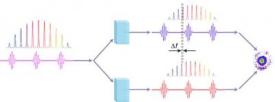Apr 6 2010
Physicists at the University of Maryland have found a way to turn a precision measurement device into a versatile tool for manipulating quantum bits (qubits).
 The spectrum of pulse trains from a mode-locked laser consists of a sequence of optical frequencies that are evenly spaced.
The spectrum of pulse trains from a mode-locked laser consists of a sequence of optical frequencies that are evenly spaced.
The researchers adapted a device known as an optical frequency comb in their novel approach to performing the sorts of quantum data operations that will be vital for future quantum computers. The research appears in this week's issue of Physical Review Letters and is described in a Viewpoint article by Boris Blinov (University of Washington) in the current edition of APS Physics (physics.aps.org).
Conventional methods for manipulating qubits typically require pairs of lasers with closely coordinated outputs and high power levels. Optical frequency combs produce a rainbow of light that's made up of discrete, precisely defined frequencies. Because the light originates from a single source, rather than two separate sources, the output frequencies in an optical comb are automatically coherent. As a result, two frequencies from a single optical comb can take the place of a pair of lasers in manipulating a qubit.
Despite the convenience the optical frequency comb offers in coherence, tailoring the output for specific applications generally involves physically adjusting the components that produce a comb. The new research demonstrates a technique that solves the problem by effectively using the "teeth" (individual frequencies in a comb output) of one comb to produce coherent pairs of teeth in another comb. This allows the researchers to electronically shift frequencies to the specific values they need, rather than being constrained by the fixed choices that a single comb provides. The flexibility of the technique should be applicable to many types of qubits. In addition, closely related techniques are proving useful for a host of other applications that involve the manipulation and control of atoms with light.